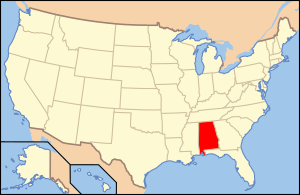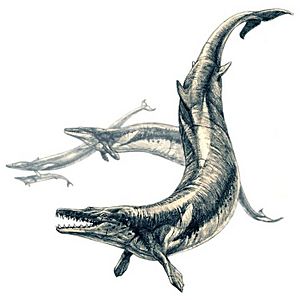Paleontology in Alabama facts for kids

Paleontology in Alabama is all about studying ancient life, like dinosaurs and other creatures, that once lived in the U.S. state of Alabama. Scientists called paleontologists dig up and study fossils to learn about Earth's past.
Long, long ago, during a time called the Paleozoic Era, parts of Alabama were covered by a warm, shallow sea. This sea was home to many different animals, including creatures like brachiopods (which look a bit like clams), corals, and tiny animals called bryozoans. Later, during the Devonian Period, the seas got deeper, and there was less oxygen, so not as many animals could live there.
Life became much more common during the Carboniferous Period. Huge swamps covered the state, filled with lush plants. Amphibians lived in these swamps, and they left behind many fossil footprints – some of the best in the world! After a long time with no new rock layers forming (the Permian Period), Alabama started to break apart as the supercontinent Pangaea split up during the Triassic Period.
Much later, in the Cretaceous Period, the state was again partly covered by a sea. This sea was full of amazing marine animals. On land, Alabama had warm, subtropical forests. The sea stayed in southern Alabama during the early part of the Cenozoic Era. Here, early whales and many small sea creatures lived. As the climate got colder, the seas pulled back. During the Ice Age, Alabama was home to giant animals like mammoths, mastodons, and huge ground sloths.
One of the most famous fossil finds in Alabama was in 1842: the discovery of an early whale called Basilosaurus. This amazing ancient whale, Basilosaurus cetoides, is now Alabama's official state fossil.
Contents
Ancient Alabama: A Journey Through Time
Life in the Paleozoic Seas
No fossils have been found from the very earliest time, the Precambrian Period, in Alabama. So, Alabama's fossil story begins in the Paleozoic Era. By the Late Cambrian Period, Alabama was covered by a warm, shallow sea. Many different kinds of animals lived in this sea.
Later, during the Late Ordovician Period, mountains rose up in Alabama. Sediments (like sand and mud) washed down from these mountains into the sea. The sea life during the Ordovician Period included brachiopods, bryozoans, corals, and graptolites (tiny colonial animals).
The same washing and depositing of sediments continued into the Silurian Period. But during the Devonian Period, the seas in Alabama became deeper. The amount of oxygen in the water dropped, making it hard for most living things to survive. Because of this, fossils from the Devonian are quite rare in Alabama.
The Age of Swamps and Amphibians
Life became plentiful again in the seas during the Mississippian Period, which is part of the larger Carboniferous Period. The word "Carboniferous" means "coal-bearing," and this period is often called the "age of amphibians" or the "age of coal swamps."
During the Mississippian, rocks called carbonates formed in the state. These rocks preserved many ancient sea creatures as fossils. The sea life included blastoids, brachiopods, bryozoans, corals, and crinoids (also known as "sea lilies").
From the Late Mississippian into the Pennsylvanian Period, Alabama was very swampy, just like the Carboniferous period's nickname suggests. During the Pennsylvanian, sediments from the mountains formed a huge coastal plain. The Black Warrior Basin in Alabama shows evidence of these ancient Carboniferous swamps.
The northern part of Alabama has many well-preserved plant fossils from these swamps. Early trees and plants that looked like ferns grew there. All this plant life eventually formed the state's large coal deposits. This region also has the biggest and most varied collection of fossil tracks from this time period anywhere in the world!
No rocks from the Permian Period are found in Alabama. This means that during that time, sediments were being worn away from Alabama, not deposited.
Dinosaurs and Ancient Seas of the Mesozoic
During the Triassic Period of the Mesozoic Era, Alabama experienced rifting. This happened as the supercontinent Pangaea began to break apart. By the Jurassic Period, the valleys created by these rifts had filled with seawater.
In the Late Cretaceous Period, Alabama was again partly covered by the sea. Many different kinds of animals lived in this sea. Oysters like Exogyra and Gryphaea were preserved in huge numbers during the Cretaceous. Other Cretaceous sea life included cephalopods (like ancient squid), corals, and gastropods (snails).
When Alabama's Mooreville Chalk rock layer was forming, the area was home to large turtles called protostegids and the shark Cretoxyrhina mantelli. This shark would sometimes leave bite marks on the turtle bones, which were preserved as fossils. Other Alabama sharks included the genus Squalicorax, which often left broken tooth tips in the bones of animals it ate, including mosasaurs (large marine reptiles) and even young hadrosaurs (duck-billed dinosaurs).
A type of large, freshwater turtle called Bothremys lived in Cretaceous Alabama and might have eaten ancient snails. Sea turtle fossils are also common in Alabama's Cretaceous rocks. In 2018, a new species of Peritresius (a type of sea turtle) was named from Alabama fossils.
Parts of Alabama not covered by the sea were home to subtropical forests. Ankylosaurs (armored dinosaurs) and Hadrosaurs (duck-billed dinosaurs) lived in the state, as did tyrannosauroids (relatives of T. rex). These local dinosaurs also left behind eggs that turned into fossils.
Ice Age Giants and Early Whales
For most of the Tertiary Period (part of the Cenozoic Era), southern Alabama was covered by the sea. The rest of the state was a coastal plain with subtropical forests.
Life in Alabama during the Paleocene Period included pelecypods (like clams). Eocene Period life included echinoids (sea urchins), gastropods, solitary corals, and sharks. The ancient whale Basilosaurus was a dominant creature in the seas of Tertiary Alabama. The Early Tertiary Claiborne Group rock layers are famous for preserving silicified Ostrea oysters (oysters turned to stone). Outcrops of the Claiborne Group also preserve fossil flowers and pollen. Oligocene Period life included disc-shaped foraminiferans (tiny single-celled organisms).
By the Pleistocene Period, Alabama's climate had become much colder. Even though this was the time of the Ice Age, Alabama was too far south to have glaciers within its borders. The northern part of the state had spruce forests. The southern part had grasslands and forests with more types of trees. Giant animals like mammoths, mastodons, and giant ground sloths lived here.
Fossil Discoveries in Alabama

The process of mining coal from the Carboniferous Period has helped uncover many fossil footprints left by early tetrapods (four-legged animals) in Alabama. These tracks are often found when coal miners dig away the rock beneath them, leaving the tracks visible on the ceiling of the mine tunnels.
One of Alabama's biggest early fossil discoveries happened in 1842. The remains of a primitive whale called Basilosaurus were found on a farm owned by Judge John Creagh in Clarke County, Alabama. Local doctors thought the fossils belonged to an ancient marine reptile. However, some of the fossils were sent to Sir Richard Owen in England. Owen realized the bones were actually from a whale and tried to rename the creature Zeuglodon. Even though he tried to change the name, the creature is still officially known as Basilosaurus. This discovery was even mentioned by Herman Melville in his famous 1851 novel, Moby Dick.
Scientists have been studying Alabama's Cretaceous Period rocks since at least 1856. In 1919, more attention was drawn to these rocks when a report from the United States Geological Survey listed over a dozen places in Alabama where plant fossils from that time could be found. These places included areas near towns like Centerville, Eufaula, and Tuscaloosa. Over the years, these sites have produced at least a hundred different kinds of ancient plants. Sadly, some of these sites were lost when a lock system was built on the Warrior River, causing them to be submerged.
In July 1961, a very exciting fossil discovery happened. A farmer in Washington County found a large fossil vertebra (a backbone bone) while ploughing his field. It turned out to belong to Basilosaurus, the ancient Tertiary whale. Further digging found almost a complete skeleton of the animal! This included 118 vertebrae, 8 ribs, and a six-foot-long skull with teeth. The bones were taken to Tuscaloosa to be part of a museum exhibit at the University of Alabama.
More recently, in 1984, Basilosaurus cetoides was officially named Alabama's state fossil. In 2005, a new type of tyrannosauroid (a dinosaur related to T. rex) called Appalachiosaurus was named based on Cretaceous fossils found in Alabama.
Paleontology Experts in Alabama
Many scientists have studied fossils in Alabama. Here are some of them:
- Truman H. Aldrich
- Gorden L. Bell, Jr.
- Scott Brande
- Timothy Abbott Conrad
- James L. Dobie
- Jun A. Ebersole
- Andrew D. Gentry
- Douglas E. Jones
- Caitlin R. Kiernan
- Adiël A. Klompmaker
- James P. Lamb
- Winifred McGlamery
- Andrew K. Rindsberg
- Herbert Huntingdon Smith
- Eugene Allen Smith
Museums to Visit
If you want to see amazing fossils and learn more about Alabama's natural history, you can visit these museums:
- Alabama Museum of Natural History, Tuscaloosa
- Anniston Museum of Natural History, Anniston
- Auburn University Museum of Natural History
- Black Belt Museum, University of West Alabama
- McWane Science Center, Birmingham

